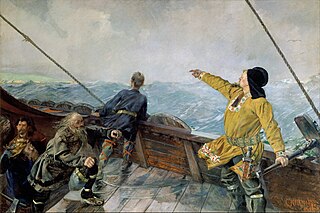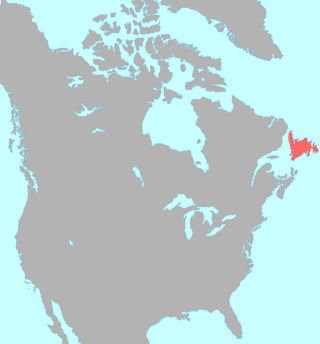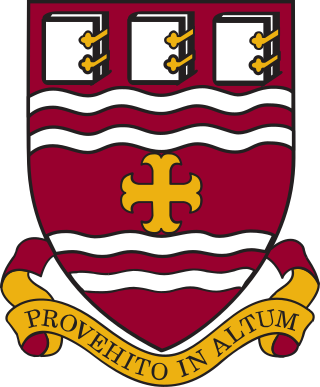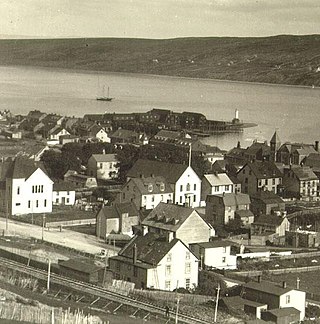
Newfoundland and Labrador is the easternmost province of Canada, in the country's Atlantic region. The province comprises the island of Newfoundland and the continental region of Labrador, having a total size of 405,212 km2 (156,453 sq mi) As of January 1, 2024, the population of Newfoundland and Labrador was estimated to be 540,552. The island of Newfoundland is home to around 94 per cent of the province's population, with more than half residing in the Avalon Peninsula. Labrador shares a land border with both the province of Quebec and the territory of Nunavut on Killiniq Island. The French overseas collectivity of Saint Pierre and Miquelon lies about 20 km (12 mi) west of the Burin Peninsula.

Vinland, Vineland, or Winland was an area of coastal North America explored by Vikings. Leif Eriksson landed there around 1000 AD, nearly five centuries before the voyages of Christopher Columbus and John Cabot. The name appears in the Vinland Sagas, and describes Newfoundland and the Gulf of Saint Lawrence as far as northeastern New Brunswick. Much of the geographical content of the sagas corresponds to present-day knowledge of transatlantic travel and North America.

The Beothuk were a group of Indigenous people who lived on the island of Newfoundland.

Memorial University of Newfoundland, also known as Memorial University or MUN, is a public research university in the province of Newfoundland and Labrador, based in St. John's, with satellite campuses in Corner Brook, elsewhere in Newfoundland and in Labrador, Saint Pierre, and Harlow, England. Memorial University offers certificate, diploma, undergraduate, graduate, and post-graduate programs, as well as online courses and degrees.

Ferryland is a town in Newfoundland and Labrador on the Avalon Peninsula. According to the 2021 Statistics Canada census, its population is 371.

The coat of arms of Newfoundland and Labrador was originally granted by Garter King of Arms, during the reign of King Charles I, on 1 January 1637/8.

Channel-Port aux Basques is a town at the extreme southwestern tip of Newfoundland fronting on the western end of the Cabot Strait. A Marine Atlantic ferry terminal is located in the town which is the primary entry point onto the island of Newfoundland and the western terminus of the Newfoundland and Labrador Route 1 in the province. The town was incorporated in 1945 and its population in the 2021 census was 3,547.

St. Anthony is a town on the northern reaches of the Great Northern Peninsula of the Canadian province of Newfoundland and Labrador. St. Anthony serves as a main service centre for northern Newfoundland and southern Labrador. St. Anthony had a population of 2,180 in 2021, compared with 2,258 in 2016, 2,418 in 2011, 2,476 in 2006 and 2,730 in 2001.

Carbonear is a town on the Avalon Peninsula in Newfoundland and Labrador, Canada. It overlooks the west side of Conception Bay and had a history long tied to fishing and shipbuilding. Since the late 20th century, its economy has changed to emphasize education, health care, retail, and industry. As of 2021, there were 4,696 people in the community.

Harbour Grace is a town in Conception Bay on the Avalon Peninsula in the province of Newfoundland and Labrador, Canada. With roots dating back to the 16th century, it is one of the oldest towns in North America.
This is a chronology and timeline of the colonization of North America, with founding dates of selected European settlements. See also European colonization of the Americas.

The province of Newfoundland and Labrador covers the period from habitation by Archaic peoples thousands of years ago to the present day.

The Canadian province of Newfoundland and Labrador has a unicameral legislature, the General Assembly composed of the Lieutenant Governor and the House of Assembly, which operates on the Westminster system of government. The executive function of government is formed by the Lieutenant Governor, the premier and his or her cabinet.
Glover Island is a large (178 km2) lake island in the interior of the Island of Newfoundland in the province of Newfoundland and Labrador, Canada. The island was named after Sir John Hawley Glover, former governor of Newfoundland. It is the 18th largest lake island in the world by area. The island is located in Grand Lake, a natural lake whose waters were raised for the Deer Lake Power Development. Historic maps show that Glover Island pre-dates this.

William Gilbert Gosling was a politician, businessman and author. From 1916 to 1920, he served as the mayor of St. John's, Newfoundland.

Newfoundland is a large island within the Canadian province of Newfoundland and Labrador. It is situated off the eastern coast of the North American mainland and the geographical region of Labrador.

Margaret Eleanor Anne Hart was a Canadian author who specialized in biographies. She was best known for her Agatha Christie character biographies: The Life and Times of Miss Jane Marple and The Life and Times of Hercule Poirot, and for her role as head of the Centre for Newfoundland Studies from 1976 until her retirement on January 1, 1998. In 2004, Hart was made a Member of the Order of Canada for her "lasting contributions to the cultural life of her province."

The art of Newfoundland and Labrador has followed a unique artistic trajectory when compared to mainland Canada, due to the geographic seclusion and socio-economic history of the province. Labradorian art possesses its own historical lineage.
















